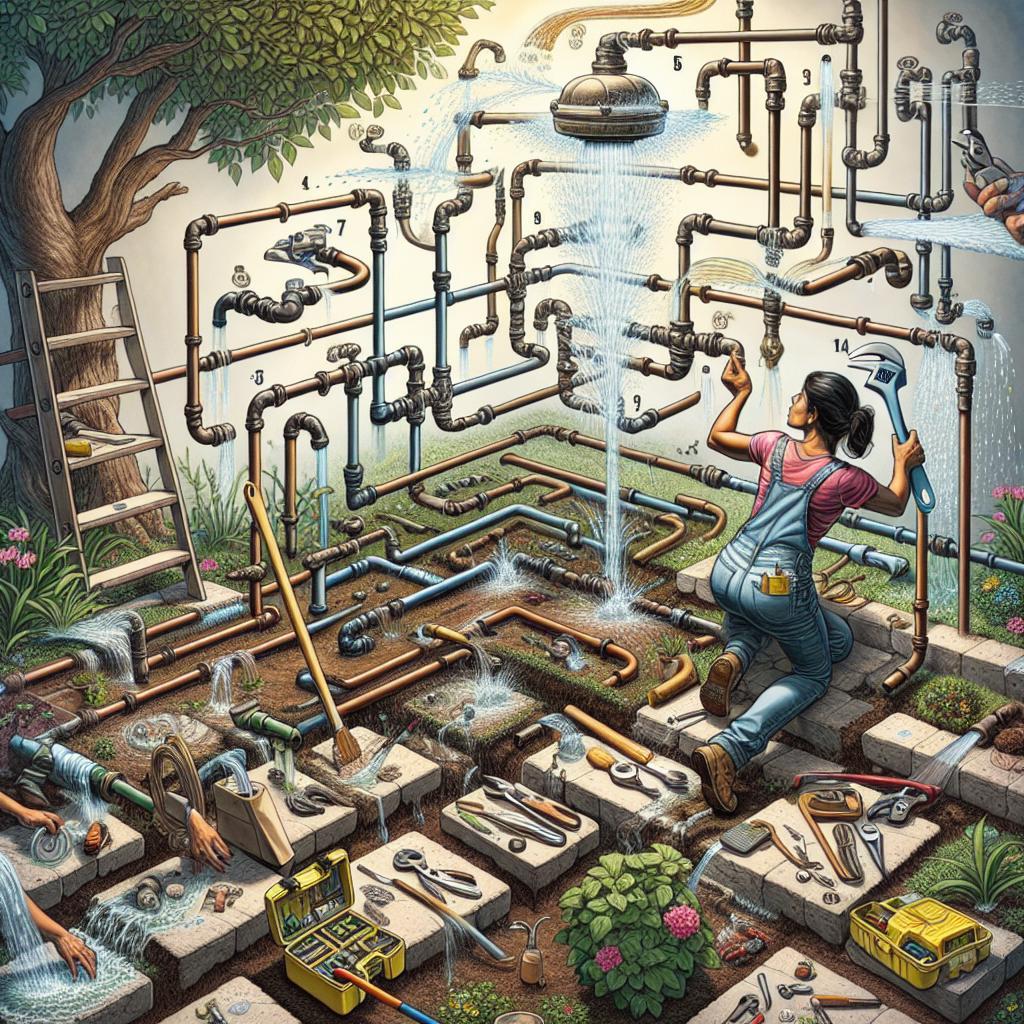This post may contain affiliate links which means I may receive a commission for purchases made through links. Learn more on my Private Policy page.
Introduction:
Picture this: it’s a sunny afternoon, and your lush garden is bursting with color, each plant thriving under the gentle kiss of hydration. but wait—what’s that? A pool of water forming where it shouldn’t? If your irrigation system is leaking, don’t fret! You’re not alone in this water-wasting conundrum. Maintaining a flourishing garden means tackling the occasional hiccup—and the good news is that fixing a leaking irrigation system can be simpler than you think. In this pleasant, step-by-step guide, we’ll walk you through the process of identifying the source of the leak, gathering your tools, and executing repairs like a pro. so roll up your sleeves,grab a cup of your favorite brew,and let’s get your irrigation system back on track,ensuring your garden stays as vibrant and healthy as ever!
Identifying the Culprits Behind the leak
Detecting the source of a leak in your irrigation system can feel like searching for a needle in a haystack.However, with a systematic approach, you can pinpoint the problem areas with relative ease. Begin by inspecting visible components,such as:
- Pipes: Look for any cracks or bulges that could indicate a failure.
- Fittings: Check for loose connections where water may seep out.
- Emitters: evaluate if they are clogged or broken, which may cause irregular water flow.
Next, conduct a pressure test to further narrow down the culprits.Turn on the system and listen carefully for hissing sounds or observe any wet spots that may indicate a leak.If the leak isn’t obvious, consider utilizing dye tests, which can definitely help visualize the water flow. You can also assess the performance of:
- Sprinkler Heads: These could be misaligned or damaged, resulting in uneven watering.
- Valves: Failing valves may fail to control the flow and contribute to leaks.
By methodically analyzing these components, you enhance your chances of swiftly and effectively addressing the leak issue.

Essential Tools and Supplies for a Successful Repair
To tackle a leaking irrigation system effectively, having the right tools and supplies at your disposal is paramount. Begin by gathering some essential hand tools that will make the repair process smoother. You’ll need:
- Adjustable Wrench – Perfect for loosening or tightening different fittings.
- Utility Knife - Useful for cutting through hoses or pipes.
- Plumber’s Tape – Essential for sealing threaded connections and preventing future leaks.
- Pipe Cutter – Ideal for making clean, precise cuts on PVC or other types of pipes.
In addition to tools, don’t forget to stock up on necessary replacement parts. Having these items on hand can reduce downtime and ensure you don’t have to make multiple trips to the store. Consider keeping these components readily available:
- Replacement Hoses – Various lengths to replace damaged sections.
- Fittings and Connectors – A range of sizes for different needs.
- Drip Emitters or Nozzles – For precise water delivery adjustments.
- Pipe Sealant – Provides an extra layer of protection against leaks.

Step-by-Step Techniques to Fix Common Irrigation Issues
Dealing with a leaking irrigation system can be frustrating, but with the right approach, you can repair it step-by-step. First,locate the leak by turning off the irrigation system and inspecting the pipes,joints,and fittings for visible moisture or wet soil. Pay extra attention to any areas that seem unusually damp. If the leak isn’t apparent, you might want to conduct a pressure test to isolate the problem area. This involves temporarily blocking sections of the system to identify where the drop in pressure occurs.
Once you’ve pinpointed the leak, it’s time to make the appropriate repairs. Depending on the nature of the issue, you might need to replace a section of pipe or tighten a loose fitting. Use the following methods for common issues: For cracked pipes,cut the damaged section out and use a coupling to connect new pieces. If a joint is leaking, apply pipe sealant or replace the affected fitting. Don’t forget to check your work by turning the water back on and monitoring for leaks. If everything looks good, cover up any disturbed soil and get back to enjoying your flourishing garden!
| Common Issues | Repair Method |
|---|---|
| Cracked Pipelines | Cut and replace affected sections |
| Loose Fittings | Tighten or replace the fitting |
| Damaged Emitters | Swap out with a new emitter |
| Clogged Drippers | Cleans with water or replace |

Preventive Measures to Keep Your System Leak-Free
To ensure your irrigation system operates smoothly and remains leak-free, it’s essential to implement a range of preventive measures. Regular maintenance is key, so set aside time for periodic inspections.Look for common issues such as:
- Cracked fittings: Inspect joints and connection points where leaks often occur.
- Clogged filters: Clean or replace filters to promote optimal water flow.
- Piping integrity: Check for signs of wear,especially in areas exposed to weather extremes.
Another proactive approach is to adjust your system according to seasonal changes. During colder months, consider winterizing your irrigation system to prevent freeze-related damage. It’s also wise to monitor water pressure, as excessive pressure can cause pipes to burst. keep a record of maintenance activities to track any recurring issues and adjust your repair strategies accordingly. Below is a simple table to help you log inspections:
| Date | Inspection Type | Notes |
|---|---|---|
| MM/DD/YYYY | Piping | Checked for cracks and blockages. |
| MM/DD/YYYY | Filters | Cleaned and replaced as needed. |
| MM/DD/YYYY | Fittings | Replaced any damaged joints. |
Key Takeaways
As we wrap up our journey through the ins and outs of repairing a leaking irrigation system, we hope you feel equipped and empowered to take on this DIY challenge with confidence! Remember, every drip tackled not only conserves water but also nurtures your patch of paradise. Embrace the satisfaction that comes from hands-on problem-solving and the reward of a flourishing garden.So gather your tools, roll up your sleeves, and let each repair be a step towards a more lasting and vibrant landscape. whether you’re tending to a small flower bed or a sprawling vegetable garden, your dedication to maintenance can make all the difference. And don’t forget, you’re not alone in this endeavor—your garden will thank you with blooms and bountiful harvests.
Happy repairing! Here’s to fewer leaks and more lush greenery in the seasons to come. 🌿✨
This post may contain affiliate links which means I may receive a commission for purchases made through links. Learn more on my Private Policy page.

